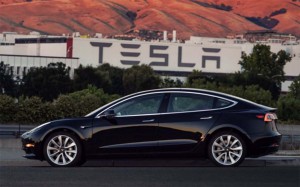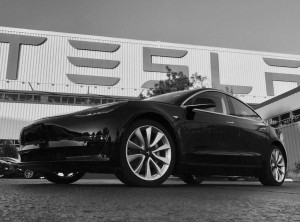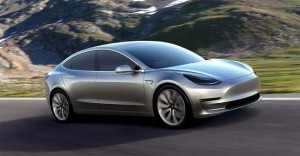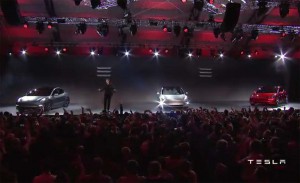Twitter-savvy Tesla CEO Elon Musk has posted a picture of what appears to be the first “saleable” Model 3 sedan to roll off the battery-carmaker’s Fremont, California assembly line, a critical step in Tesla’s push to become a truly mainstream manufacturer.
But the company appears to have pushed back on its promise to start taking official orders for the new Tesla Model 3 on Friday and still has not given a clear sense of pricing for the compact battery-electric vehicle. A visit to the Tesla website only reveals the same information that had been up there for some time, among other things noting a “starting price” of $35,000.
Tesla has a lot riding on the Model 3 launch. Though there are plenty of skeptics, Musk has outlined a plan that would take the company’s production to 500,000 vehicles in 2018 – a sixfold increase from 2016 – and Model 3 would account for about 80% of that total.
This first, black Model 3 already has a home, apparently. It apparently was due to go to Tesla board member Ira Ehrenpreis, the first to put down a reservation and deposit. But he has apparently given the rights to the first car to CEO Musk as a birthday present. He turned 46 on June 28th.
As for retail customers, beyond the starting price, it’s unclear precisely what a typically equipped Model 3 will go for. The company is expected to offer some options, including its semi-autonomous Autopilot technology. It is uncertain whether buyers will get the option to upgrade to a battery pack offering more than the base 215-mile range, as is the case with the current Models S and X. Tesla has only confirmed it will offer 18- and 19-inch wheel options.
“Initially, the Model 3 configurator it’s going to be like “what color do you want? and what size wheel do you want?”. That’s basically going to be the configurator,” said Musk in a tweet.
The configurator will also show future options, such as a dual-motor version of the Model 3, similar to such existing products as the larger Model S P100d. That, according to Musk, is due “late 2017 or early 2018.”
Tesla previously said it would charge Model 3 customers to use the company’s high-speed Supercharger network. The feature is built into the price of Tesla’s more expensive products.
Barely a month ago, Tesla stock zoomed to record levels following Musk’s announcement that the first Model 3 would roll down the line in July, the first product the company has launched to meet its production target. But things haven’t gone nearly as well since the beginning of July. Tesla’s stock plunged by nearly 20% last week, briefly entering “bear” territory, before settling in at $313.50 before the start of trading Monday morning. Shares were rebounding slightly at the start of the week’s trading, but Tesla is still off more than $70 from the record $386.99 high set in June.
(A good week gone bad for Tesla. Click Here for more.)
Any number of issues have sent investors scurrying:
- Relatively week second-quarter sales, which were up 53% year-over-year but down 12% from first quarter numbers;
- Demand in California, Tesla’s top market, were especially weak;
- The Model S sedan fared poorly in a key crash test and failed to earn the coveted Insurance Institute for Highway Safety “Top Safety Pick+” rating;
- Key analysts have amped up warnings about Tesla stock, , including David Tamberrino, of Goldman Sachs, who sees a long-term price of between just $170 and $180 a share;
- Volvo announced plans to electrify its entire line-up, emphasizing that most manufacturers are migrating to hybrid, plug-in and pure battery-electric power, a more direct challenge to Tesla.
(Click Here for more on Volvo’s move to electrify its line-up.)
Add the fact that Tesla acknowledged its weak second-quarter sales numbers were the result of problems with its largest battery pack, a reminder of the ongoing quality issues that have plagued older products since Tesla first came to market. Industry observers have repeatedly warned that if the Model 3 has issues similar to what happened when the Model X battery-SUV was launched in 2015 it could short-circuit the company’s aggressive expansion plans.
Shortly after the Model 3 was first unveiled on March 31, 2016, Tesla indicated it had received more than 300,000 advance orders. The company has not updated that figure, though analysts have estimated it is currently somewhere between 400,000 and 500,000. For his part, Musk indicated Tesla has about 18 months of back orders based on its current production ramp-up schedule. That means deliveries wouldn’t be completed until sometime in 2019, even if it received no additional orders – but Tesla says it has continued to book more early reservations.
The real test will come this month when the order configurator goes into operation and we get to see if those reservations actually will translate into paid sales.
(France expected to ban all gas, diesel vehicles. Click Here for the full story.)





I’m still waiting to see a photo of the production interior–you know, the one with the spaceship-inspired controls… 😉
https://twitter.com/elonmusk/status/716729420078133248
We’re waiting for lots more, as well!